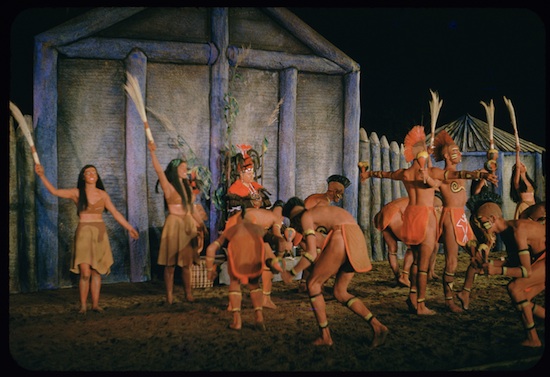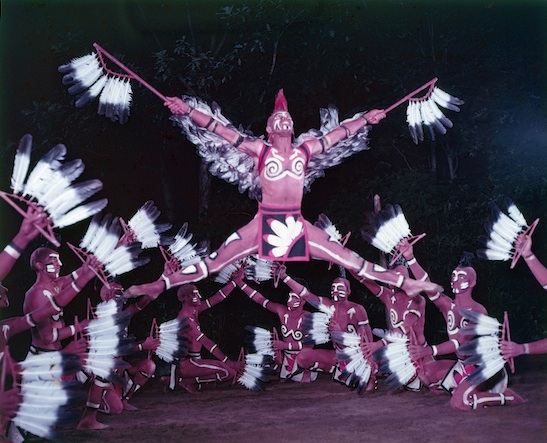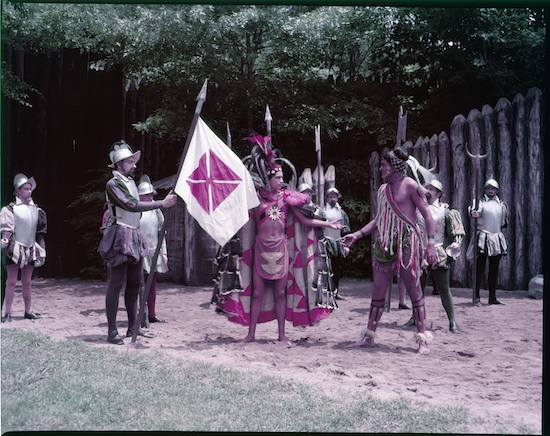Note from Elizabeth: Sixty years ago today, the historical drama “Unto These Hills” premiered at Cherokee, NC. We’re thrilled to present a guest post on the topic by Worth 1,000 Words essay author Andrew Denson of Western Carolina University.
This month marks the sixtieth anniversary of the outdoor historical drama “Unto These Hills,” which debuted in Cherokee on the evening of July 1, 1950. A vivid recounting of Cherokee history from European contact through the Removal era, the play was an immediate success, drawing large audiences throughout its first season. “Huge crowds have been present,” The State magazine proclaimed in its July 15, 1950 issue, and “everyone who has seen it thus far is enthusiastic.” Drawing more than 100,000 viewers in its first season alone, the drama quickly became one of Western North Carolina’s premier tourist attractions. In a significantly revised form, it remains popular today.

Hugh Morton captured some of the excitement of those early performances in a series of striking color images, now preserved in the Morton digital collection. The play’s dance sequences, in particular, seem to have drawn his photographer’s eye. He documented the “harvest dance” seen at the beginning of the drama and meant to express the Cherokees’ respectful relationship with the land (they “possessed it with gentleness and humility, with peace,” reads the script by Kermit Hunter). He also recorded the athletic “eagle dance,” which reviewers of the drama invariably cited as one of play’s most arresting moments. With modern choreography by UNC drama professor Foster Fitz-Simons, these performances bore little resemblance to traditional Cherokee dance, but they certainly gripped viewers’ attention. Fitz-Simons’ version of the eagle dance, in fact, became an all-purpose emblem of the drama, appearing in advertising for “Unto These Hills” for years to come.

The original “Unto These Hills,” it must be said, was rather poor history. Kermit Hunter, who wrote the script as a UNC graduate student, knew little about the Native American or Appalachian past, and his research seems not to have extended much beyond a cursory reading of James Mooney’s Myths of the Cherokee. Hunter portrayed Cherokees sympathetically, as honest people who loved and defended their land, yet his Indian characters were little more than stereotypes. Seeking to appeal to a broad audience, Hunter relied on familiar images like the “noble savage,” turning fascinating figures like Sequoyah and the Cherokee leader Drowning Bear into flat caricatures. The play depicted real events, but only in a form devoid of historical complexity.

But perhaps that judgment is unfair. The creators of “Unto These Hills” transformed a somewhat obscure historical subject into compelling popular entertainment, which was no small feat. In the process, the drama may have accomplished something more. For all of its flaws, “Unto These Hills” ensured that several generations of visitors to the mountains departed knowing that Western North Carolina was the Cherokee homeland and that Cherokees had persisted there. That was a message worth broadcasting. Sixty years later, it remains so.
–Andrew Denson
REFERENCES
Beard-Moose, Christina Taylor. Public Indians, Private Cherokees: Tourism and Tradition on Tribal Grounds. Tuscaloosa: University of Alabama Press, 2009.
Finger, John R. Cherokee Americans: The Eastern Band of Cherokees in the Twentieth Century. Lincoln: University of Nebraska Press, 1991.
Hunter, Kermit. Unto These Hills: A Drama of the Cherokee. Chapel Hill: University of North Carolina Press, 1951.
The State, July 15, 1950.

Interesting article in this morning’s Asheville paper online:
http://www.citizen-times.com/article/20100709/ENT/307090017/1005/ENT?source=nletter-news
This really brings back the memories. I remember going to see “Unto These Hills” with my family when I was a kid, in the 1960s. I guess that was when the play still leaned heavily on the stereotypes mentioned in the article. It would be interesting to see how it has been revised. Just hope it hasn’t gone too far in a different direction to meet political correctness criteria or something!
I had seen “Unto These Hills” several years ago first. And, we wanted to give our kids something interesting and educational so we went to see it again.
We were a little concerned about the show, but were really surprised at how the show moved along. Compared to several years ago, when the show pretty much ended at the Trail of Tears, this version is much better. The Cherokee seem to be fighting hard to keep their culture alive, and the current version of this show does some “pep rally” about the culture looking to the future.
I want to see “Unto These Hills” to perform live. When is the next performance of yours?
Thanks